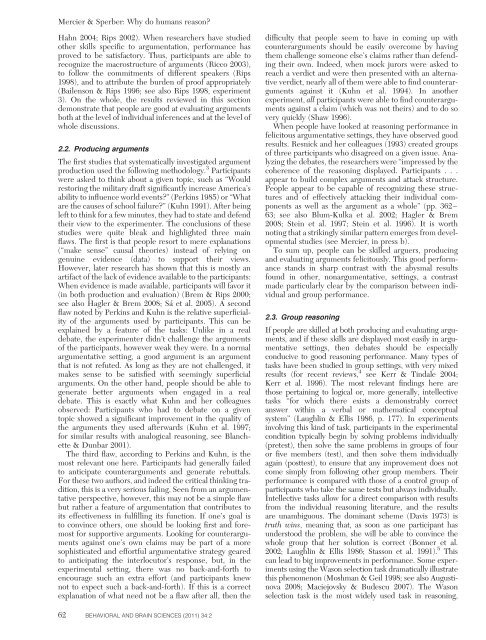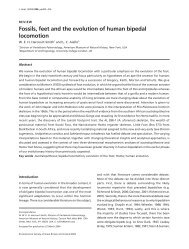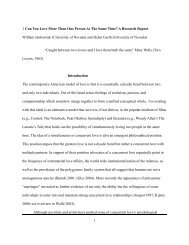Why do humans reason? Arguments for an argumentative theory
Why do humans reason? Arguments for an argumentative theory
Why do humans reason? Arguments for an argumentative theory
You also want an ePaper? Increase the reach of your titles
YUMPU automatically turns print PDFs into web optimized ePapers that Google loves.
Mercier & Sperber: <strong>Why</strong> <strong>do</strong> <strong>hum<strong>an</strong>s</strong> <strong>reason</strong>?Hahn 2004; Rips 2002). When researchers have studie<strong>do</strong>ther skills specific to argumentation, per<strong>for</strong>m<strong>an</strong>ce hasproved to be satisfactory. Thus, particip<strong>an</strong>ts are able torecognize the macrostructure of arguments (Ricco 2003),to follow the commitments of different speakers (Rips1998), <strong>an</strong>d to attribute the burden of proof appropriately(Bailenson & Rips 1996; see also Rips 1998, experiment3). On the whole, the results reviewed in this sectiondemonstrate that people are good at evaluating argumentsboth at the level of individual inferences <strong>an</strong>d at the level ofwhole discussions.2.2. Producing argumentsThe first studies that systematically investigated argumentproduction used the following metho<strong>do</strong>logy. 3 Particip<strong>an</strong>tswere asked to think about a given topic, such as “Wouldrestoring the military draft signific<strong>an</strong>tly increase America’sability to influence world events?” (Perkins 1985) or “Whatare the causes of school failure?” (Kuhn 1991). After beingleft to think <strong>for</strong> a few minutes, they had to state <strong>an</strong>d defendtheir view to the experimenter. The conclusions of thesestudies were quite bleak <strong>an</strong>d highlighted three mainflaws. The first is that people resort to mere expl<strong>an</strong>ations(“make sense” causal theories) instead of relying ongenuine evidence (data) to support their views.However, later research has shown that this is mostly <strong>an</strong>artifact of the lack of evidence available to the particip<strong>an</strong>ts:When evidence is made available, particip<strong>an</strong>ts will favor it(in both production <strong>an</strong>d evaluation) (Brem & Rips 2000;see also Hagler & Brem 2008; Sá et al. 2005). A secondflaw noted by Perkins <strong>an</strong>d Kuhn is the relative superficialityof the arguments used by particip<strong>an</strong>ts. This c<strong>an</strong> beexplained by a feature of the tasks: Unlike in a realdebate, the experimenter didn’t challenge the argumentsof the particip<strong>an</strong>ts, however weak they were. In a normal<strong>argumentative</strong> setting, a good argument is <strong>an</strong> argumentthat is not refuted. As long as they are not challenged, itmakes sense to be satisfied with seemingly superficialarguments. On the other h<strong>an</strong>d, people should be able togenerate better arguments when engaged in a realdebate. This is exactly what Kuhn <strong>an</strong>d her colleaguesobserved: Particip<strong>an</strong>ts who had to debate on a giventopic showed a signific<strong>an</strong>t improvement in the quality ofthe arguments they used afterwards (Kuhn et al. 1997;<strong>for</strong> similar results with <strong>an</strong>alogical <strong>reason</strong>ing, see Bl<strong>an</strong>chette& Dunbar 2001).The third flaw, according to Perkins <strong>an</strong>d Kuhn, is themost relev<strong>an</strong>t one here. Particip<strong>an</strong>ts had generally failedto <strong>an</strong>ticipate counterarguments <strong>an</strong>d generate rebuttals.For these two authors, <strong>an</strong>d indeed the critical thinking tradition,this is a very serious failing. Seen from <strong>an</strong> <strong>argumentative</strong>perspective, however, this may not be a simple flawbut rather a feature of argumentation that contributes toits effectiveness in fulfilling its function. If one’s goal isto convince others, one should be looking first <strong>an</strong>d <strong>for</strong>emost<strong>for</strong> supportive arguments. Looking <strong>for</strong> counterargumentsagainst one’s own claims may be part of a moresophisticated <strong>an</strong>d ef<strong>for</strong>tful <strong>argumentative</strong> strategy gearedto <strong>an</strong>ticipating the interlocutor’s response, but, in theexperimental setting, there was no back-<strong>an</strong>d-<strong>for</strong>th toencourage such <strong>an</strong> extra ef<strong>for</strong>t (<strong>an</strong>d particip<strong>an</strong>ts knewnot to expect such a back-<strong>an</strong>d-<strong>for</strong>th). If this is a correctexpl<strong>an</strong>ation of what need not be a flaw after all, then thedifficulty that people seem to have in coming up withcounterarguments should be easily overcome by havingthem challenge someone else’s claims rather th<strong>an</strong> defendingtheir own. Indeed, when mock jurors were asked toreach a verdict <strong>an</strong>d were then presented with <strong>an</strong> alternativeverdict, nearly all of them were able to find counterargumentsagainst it (Kuhn et al. 1994). In <strong>an</strong>otherexperiment, all particip<strong>an</strong>ts were able to find counterargumentsagainst a claim (which was not theirs) <strong>an</strong>d to <strong>do</strong> sovery quickly (Shaw 1996).When people have looked at <strong>reason</strong>ing per<strong>for</strong>m<strong>an</strong>ce infelicitous <strong>argumentative</strong> settings, they have observed goodresults. Resnick <strong>an</strong>d her colleagues (1993) created groupsof three particip<strong>an</strong>ts who disagreed on a given issue. Analyzingthe debates, the researchers were “impressed by thecoherence of the <strong>reason</strong>ing displayed. Particip<strong>an</strong>ts . . .appear to build complex arguments <strong>an</strong>d attack structure.People appear to be capable of recognizing these structures<strong>an</strong>d of effectively attacking their individual componentsas well as the argument as a whole” (pp. 362–63; see also Blum-Kulka et al. 2002; Hagler & Brem2008; Stein et al. 1997; Stein et al. 1996). It is worthnoting that a strikingly similar pattern emerges from developmentalstudies (see Mercier, in press b).To sum up, people c<strong>an</strong> be skilled arguers, producing<strong>an</strong>d evaluating arguments felicitously. This good per<strong>for</strong>m<strong>an</strong>cest<strong>an</strong>ds in sharp contrast with the abysmal resultsfound in other, non<strong>argumentative</strong>, settings, a contrastmade particularly clear by the comparison between individual<strong>an</strong>d group per<strong>for</strong>m<strong>an</strong>ce.2.3. Group <strong>reason</strong>ingIf people are skilled at both producing <strong>an</strong>d evaluating arguments,<strong>an</strong>d if these skills are displayed most easily in <strong>argumentative</strong>settings, then debates should be especiallyconducive to good <strong>reason</strong>ing per<strong>for</strong>m<strong>an</strong>ce. M<strong>an</strong>y types oftasks have been studied in group settings, with very mixedresults (<strong>for</strong> recent reviews, 4 see Kerr & Tindale 2004;Kerr et al. 1996). The most relev<strong>an</strong>t findings here arethose pertaining to logical or, more generally, intellectivetasks “<strong>for</strong> which there exists a demonstrably correct<strong>an</strong>swer within a verbal or mathematical conceptualsystem” (Laughlin & Ellis 1986, p. 177). In experimentsinvolving this kind of task, particip<strong>an</strong>ts in the experimentalcondition typically begin by solving problems individually(pretest), then solve the same problems in groups of fouror five members (test), <strong>an</strong>d then solve them individuallyagain (posttest), to ensure that <strong>an</strong>y improvement <strong>do</strong>es notcome simply from following other group members. Theirper<strong>for</strong>m<strong>an</strong>ce is compared with those of a control group ofparticip<strong>an</strong>ts who take the same tests but always individually.Intellective tasks allow <strong>for</strong> a direct comparison with resultsfrom the individual <strong>reason</strong>ing literature, <strong>an</strong>d the resultsare unambiguous. The <strong>do</strong>min<strong>an</strong>t scheme (Davis 1973) istruth wins, me<strong>an</strong>ing that, as soon as one particip<strong>an</strong>t hasunderstood the problem, she will be able to convince thewhole group that her solution is correct (Bonner et al.2002; Laughlin & Ellis 1986; Stasson et al. 1991). 5 Thisc<strong>an</strong> lead to big improvements in per<strong>for</strong>m<strong>an</strong>ce. Some experimentsusing the Wason selection task dramatically illustratethis phenomenon (Moshm<strong>an</strong> & Geil 1998; see also Augustinova2008; Maciejovsky & Budescu 2007). The Wasonselection task is the most widely used task in <strong>reason</strong>ing,62 BEHAVIORAL AND BRAIN SCIENCES (2011) 34:2




